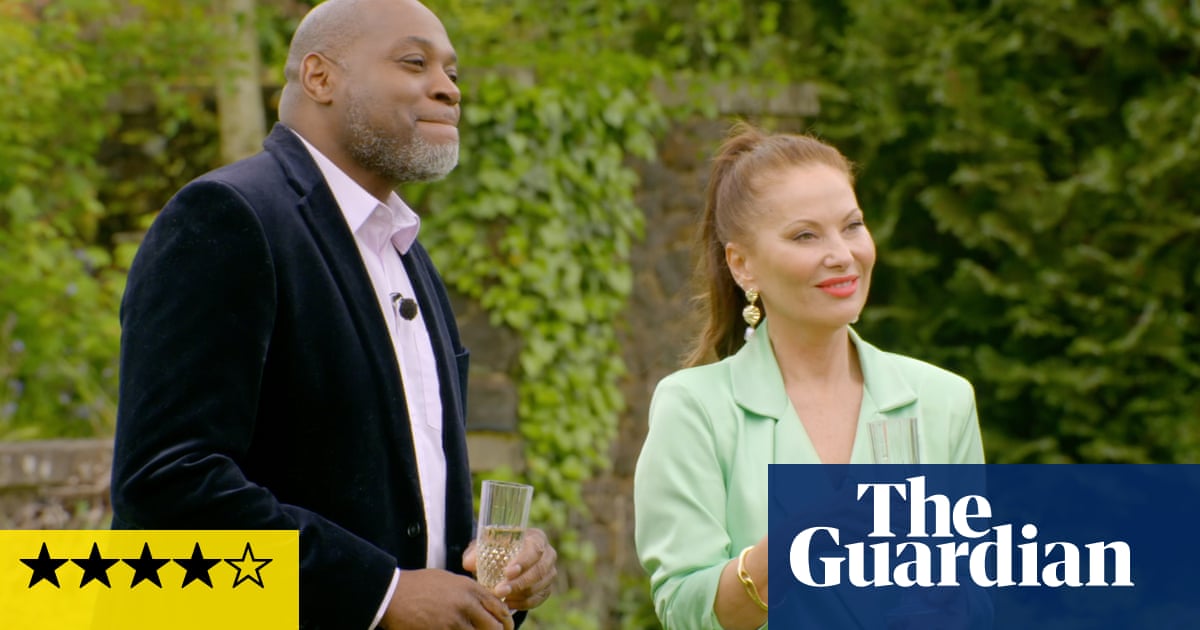
Could Nicole Kidman possibly be real? That was the question springing from her photoshoot for Perfect magazine, in which the 55-year-old adopts a power victory pose, flexing arms like a bodybuilder, her biceps taut, huge, extremely detailed. She looks like an anatomical drawing, and as if she could pull a truck out of a swamp. I was bewitched by her legs. It’s difficult to see muscle definition, head on, on a leg. Oh boy, not any more. The Daily Mail said she looked “decades younger” than her age, which is not true, since we don’t tend to age one another by our arms (it’s all in the eyes, folks). What she does look is absolutely ripped, in her 50s. She looks like an elite athlete, as does Davina McCall, 54, with her rock-hard six-pack and even Huw Edwards, 61, who caused a stir by showing off his toned torso on Instagram.
There has been a trend for visible strength in the female form in the past few years, driven by millennials, who exercise differently. They focus on body-strength training and urban calisthenics, using online coaches, motivational Instagram communities and better, less fat-depositing lifestyles. Yet the important difference is in their sexual politics.
When we who are in, or about to enter, our 50s were young, the female ideal was to be incredibly lithe and slim. Muscle definition, especially in – God help you – the shoulders, was considered beefy and undesirable. Visible triceps were OK, indicative of low body fat, but it’s quite hard to tone your triceps while leaving your shoulders unaffected. I remember being warned against rowing as an activity, with a scare story about someone’s sister who had tried it a few times and ended up looking like a wrestler. There were myths peddled as fact that, if you accidentally were to build a muscle and then not tend it, it would turn into immovable fat, hence Big Daddy. You would have this terrible ratchet where you’d build a muscle, tend the muscle, accidentally build more, and if you ever stopped, you’d run to seed, and nobody would ever love you. Theoretically, this could carry on until you became the Hulk, so it was safer just to stick with aerobics. This was all predicated on the idea that the ultimate femininity was to be as different as possible from the male, with your meaning as a woman generated by your difference from a man, in the Derridean tradition. Women born after the mid-80s just aren’t swallowing that any more.
So it has become rather ageing not to have muscle definition, and frontier celebrities such as Madonna have been very clear on this point for years. I wouldn’t say it has entirely percolated to the general population, however. “People in their 50s want to get rid of their bellies, usually,” says Leon Bolmeer, 51, owner of Geezers Boxing in Heacham, Norfolk. Personal trainer Lucinda Meade, 58, says: “Most people want to look strong but natural.”
But say getting ripped in your 50s is what you want, might you do yourself a mischief? How hard would it be, and can it be done from a standing start (or more likely, a sitting start)?
Yes, anything’s possible, says Jenny Stoute, 57, a former Olympian and Gladiator. “It’s all down to the individual and how committed they are to themselves. If you’ve got a good enough diet, and you’re sticking to your gameplan, working out, then of course you can change your body.” The likelihood is that you won’t end up looking like Kidman, however, unless you looked like her to begin with. “We can’t legislate for people’s body type,” Stoute continues. “If you’ve got very good body composition, then you’re one of the lucky ones.”
So what is it going to take? Don’t kid yourself: when you can see a muscle in all its glory, it’s because it’s not hiding under a blanket of fat. Diet is a necessary but insufficient part of getting ripped: you could strip all your fat away and still not have much muscle to show for it, but you cannot see the muscle if you can still see the fat. And it’s harder to reduce body fat as you age, because the way you process blood sugar changes. I cannot stress this enough: ridding yourself of body fat is not having a nice, balanced diet with lots of different colours on your plate and no cake. It is pretty extreme and not at all Instagrammable: I once interviewed Helen O’Reilly, AKA Panther the Gladiator, when she was getting ready for a competition, and all she had eaten the day before was 18 chicken breasts.
“Then you’ve got to think, what is your skin going to look like?” Meade advises. “What’s your collagen like? I know that, for me, if I lose a lot of weight, I’m going to have skin hanging off me.”
Stoute agrees: “We have to be very careful that we don’t get too skinny and too gaunt, because when you get older, it’s very ageing.”
As for muscle hypertrophy, the act of getting a muscle and making it bigger, that’s not for the fainthearted. “It means training every muscle group to exhaustion, two or three times a week,” Meade says. “You’re damaging that muscle, then you have to rest it, then it builds back up with protein synthesis to end up larger. It takes time, and you have to be prepared to go into discomfort.” This brings us to the question: are you willing to be the most important person in your schedule? “It is possible, but it comes at the sacrifice of everyone around you, doesn’t it?” Bolmeer says ruminatively. “You’re probably at your most stressed this decade: parents pass away, men and women take on all the responsibility of their families. That’s probably the problem in your 50s – you come last.”
While you can become incredibly ripped when you’re younger using nothing but your own body weight and maybe some bars in a pinch, you’ll need weights as you age as your muscles are already disintegrating (sorry to be a downer). So it helps if you have a pre-existing gym ethic – as in you genuinely enjoy being there – as well as some foundation in strength training. It basically helps if you’re Stoute – “I would work out all day every day if I could. That’s my buzz” – but we can’t all be Olympians.
You do have some advantages at this stage of your life. It’s said that you have more stamina as you age. That’s what it looks like, if you ever see a seniors’ Ironman or similar, a sudden injection of staying power, an unexpected gift from the universe. That’s not quite it, though: “We’ve been on the planet long enough that, by this age, we’ve got a good understanding of our bodies,” Stoute says. You know instinctively when to rest and how much rest you need, you don’t run out of steam. “We used to hold the veteran triathlon championships where I worked in the army,” Bolmeer says, “and their stamina was unbelievable. But they worked, and then they lay down for 12 hours.”
The pitfalls are: for both sexes, you’re going to knacker your joints unless you listen to them. If there are things Stoute can’t do because she’ll wreck her lower back and knees, there are definitely things you can’t do. You can’t argue with your wrists, for a start. It’s not so much a trade-off (you’re going to be helping your joints long term if you build muscle around them), but it is a constant consideration, which will certainly interrupt your hypertrophy plans now and again.
Relatedly, posture is key, particularly your back and, for women, your pelvic floor. It’s impossible to overstate how bad they were, those five sitting-down decades you just did. “That does do you in as much as being a builder,” Bolmeer says. So even though your training goals are principally trying to exhaust yourself three times a week, you’ll also have to build in time for something such as pilates or yoga. “You cannot do the training required unless your pelvic floor is in order,” Meade says. “That’s the main postural thing that’s keeping you upright. If you’re peeing yourself when you lift a heavy weight, or have painful sex, your pelvic floor is not in order.”
Is it worth all this pain? I did a fit in my 40s column, and for a while, in between the street dance classes and Hiit workouts, I had really great arms. I’d be in a barre class next to a room-length mirror, thinking: “Wow. I could probably be in an advert, so long as they airbrushed out my head and it was an advert for arms.” I’m not sure that it improved my quality of life, however. Getting ripped is mainly an aesthetic decision, and if you do get that washboard stomach, what are you going to do with it – wear a crop top? To the garden centre?
Without question, though, any muscle you build, you will thank yourself for in your 70s and 80s. It’s peculiar how well versed we are (even if we do nothing about it) in cancer and heart disease and how to prevent them, when falls are a huge factor in poor quality of life, and building muscle mass a really obvious prophylactic.
Finally, are there any shortcuts? Yes, according to YouTube, with its numerous adverts for the “electronic muscle stimulator that melts body fat”. Muscle stimulation does have medical uses, for re-educating muscles, reducing muscle spasms and preventing muscle atrophy, after a stroke or accident. But there is as yet no evidence of girth reduction, fat melting or “rock-hard abs”.
There are also camouflage effects you could try. One time, a friend wanted to go to a fancy-dress party as a ringmaster, and he got a makeup artist to paint a six-pack on his stomach. It might have worked, had he not spent the whole night going: “Look at this incredible makeup job on my fat tum.” But there are other things he could have tried, such as wearing a shirt. It’s not in the ringmaster code, that you have to go bare-chested.
In conclusion, of course you can become ripped if you want to. This is almost the cornerstone of the health and fitness creed, that anything is possible if you want it hard enough. You have my blessing, but I’m not sure I’d lay a bet on you.










